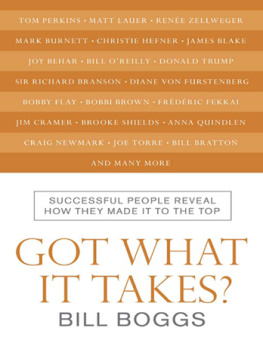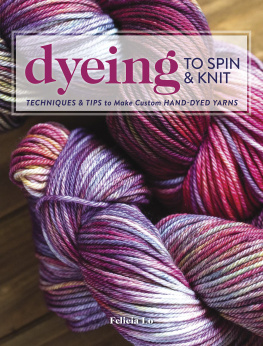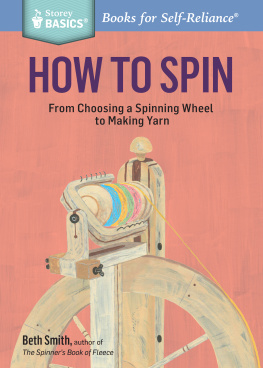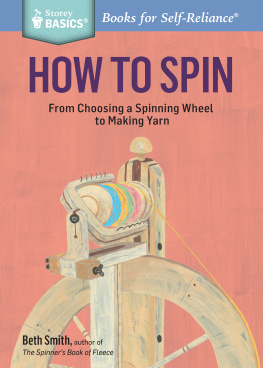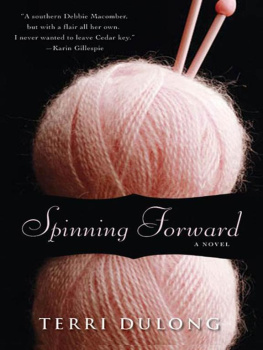Spin Art
MASTERING THE CRAFT OF SPINNING TEXTURED YARN
Jacey Boggs

To Kitten: Without you my life would be filled with far more what ifs.
To Utah, Olive, and Zeke: Success comes in many shapes; my biggest successes are shaped just like the three of you.

Acknowledgments
Kitten, for the encouragement, the time, the editing, the illustrations, and the general super-awesomeness: you make me better. My kids, for their collective creativity and inspiration: you were the first things I made that I was proud of, and that has made all the difference. My mom, Sherris, for always being there to take up any slack. My pop, Brett, for loving handknits more than any non-knitter I know. You all are my family and made this book possible by making my life full and happy. I could write a much thicker book about how much I love you all.
Christie Brown, who swatched all the yarns in the book for me and who is a wonderful friend and travel companion (despite the snoring). Azur Zouiden, for never wavering.
Linda Ligon, who once told me that despite my outlaw appearance I had a beautiful aesthetic. Well, this outlaw thanks her for being a wonderful mentor and diligent cheerleader. Judith MacKenzie, for the inspiration, information, and constant support. Anne Merrow, my original editor, for the help, the guidance, the encouragement, the talks, and the wheel. Id have been lst without her. Ellen Wheat, my new editor, who is so on top of things and thorough that it was hard for her to let that last sentence go to print without fixing it. She has been more than an editorshe has been an advocate and friend. Amy Clarke Moore, for teaching me the ropes. She is a kind and smart woman. Ann Swanson, for making me look and feel good. Her charm and generosity match her skill and creativity. Joaquin Phoenix mc, for being the face on the video monitor. He was a great fake-listener while I fake-taught him to fake-spin. Mandie Chandler, who took my extremely long and intimidating list of fiber types, preparations, and colors and delivered beyond my wildest imagination. She is a big part of the beauty on these pages. Maggie Casey, for the skillful technical editing: without her, people might think that I really dont know my maiden from my orifice. Beth Smith, my first and best long-distance fiber friend, for all the answers and advice. Gord Lendrum, for making a fantastic wheel and for using the word fresh instead of interesting. Mark Brock-Cancellieri and Jonas Prida, who together with Kitten make up Save vs. Poison, without which I wouldnt know that spinning could be my job. Christopher and Joolee from Aminibigcircus: again, where would I be without you?
Also, thanks to: Interweave; Morgaine Wilder; Suzanne Pederson; Abby Franquemont; Garrett Evans; Diane Varney; Elizabeth Zimmerman; Jillian Moreno; Rebecca Campbell; Sarah Anderson; Lexi Boeger; Ravelry; Shuttles, Spindles, and Skeins; and all the spinners Ive ever sat beside or across from. You all taught me so much.

Contents
I learned to spin yarn barely two weeks after I learned to knit. Like so many new knitters, I was still knitting with craft store yarn, and when my internal calculations told me that to knit a sweater Id be shelling out upward of $15, I was shocked!
I was nave.
It was that navet that led me to think there must be a cheaper way, and so I purchased a used Louet S-10 online in the hope that I could spin my own yarn for cheaper than I could buy it. Like I said, nave. Ten days later and $100 lighter, I sat down and put foot to treadle for the first time.
I was in love.
For the next two years, I spent at least four hours each day spinning in the corner of the dining room, behind the table, and in front of the window air-conditioning unit, while my son teethed, then crawled, then finally walked. I pored over every spinning and fiber book that my local library carried. When Id absorbed all of their information, I ordered from other libraries. I perused magazines. I scoured the Internet. If it was about spinning, I wanted to know it. My inchworm draw slowly changed to a comfortable short backward draft, then stretched to a graceful long draw. Plying came naturally, and the science of twist and balance seemed intuitive. Eventually I could spin without watching, and my yarns thinned and evened.
I spun and I knit and I was happy. I also blogged. Handspun yarn was not easily found online at that point, so when I started posting process and finished pictures, readers started asking to buy. The most daring thing I spun and sold was singles, but mostly traditional 2-plies paid the bills.
And then the experiments began.
Some artistic spinners were pulling some fun textural stunts, and I tried my hand at them. After having spent so many hours working to make my yarns even and balanced, though, the lack of control and durability in these textured yarns frustrated me. Still, I set about learning everything I could about the tricks and techniques that these less traditional spinners were doing or had done in the past. Then I experimented with how to adapt and develop what Id learned in order to create more controlled and sturdier yarns. I realized these two aspects, controlled spinning and creative textural techniques, could and should be married. All of the following skills directly influenced my textural spinning and made it better: having control over ones hands and feet; understanding different types of fibers; knowing how twist works, where it accumulates, and how it impacts plying; and how staple length affects drafting, hand distance, and drape. Knowing how to spin is paramount. My controlling nature finally paid off in demanding that everything be exact, neat, and durable. I scaled things down, refined hand movements, and introduced anchors. After Id adapted what was already out there, I started experimenting with new textures and combinations.
And the world opened up.
Today, I teach workshops all over the world. I teach the textural techniques in this bookthe hand movements for them, the reasons and science behind them, what works and what doesnt work, and why. But what I really hope that the spinners I teach take away with them is that the more you learn about spinning, the better spinner youll be. That the old adage, Know the rules before you break them, doesnt really apply. You cant break the rules of fiber and spinning and still produce a good yarn: you have to learn the rules well enough that you can work inside their parameters to get the fiber to produce the yarn you want. Traditional spinners will gain insight, dexterity, and control when they venture to spin texturally. Textural spinners will gain insight, dexterity, and control when they endeavor to spin traditionally. Traditional and textural spinning are two sides of the same cointwo plies in the same yarn. One just happens to be bumpier than the other.






